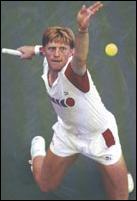Revolutionary Tennis |
||
Tennis Instruction That Makes Sense |
||
Step 12 The Tennis Serve Part 3: 3ts: Toss, Trophy, & Twist First things first: the arms indeed go down together and up together during the serve. "Down together, up together" occurs. No one says "up together evenly." Both arms don't rise up at the same clip or reach the same height at the same time, duh, but they begin in sync going down and in sync they start going up. If not the back elbow stays too low and/or you bend the racket arm too soon. The arms are like two trains that leave the train station at the same time, branch off in their different ways at the same time and then travel at different speeds because they are not identically outfitted. To say "up together" does not occur is to say one arm hangs down at 6 o'clock motionless while the other rises. Poppycock. THE TOSS ARM
The toss arm works like a hand lever on a water pump, it simply goes straight down and then straight up retracing the same path in both directions. Straight down, straight up. Simple. Boring. The toss arm is bent holding the ball to begin with, then lowers to straighten itself before lifting up straight as a whole unit. [Here the arm unbends to straighten for execution, unlike the backhand where the mantra for the stroke arm is not to straighten when it bends/unbends, or folds/unfolds.]
How do you hold the ball? I was taught to hold it like holding a triangular paper cup where the ball pops up from between your index finger and thumb, but any old way seems to work nowadays and you'll find ample info on this elsewhere. But to add, the hand does not throw the ball up, you open the fingers and the ball is released. The momentum of the toss arm going up and of your body moving is how you "toss" the ball. The toss arm itself works as a whole. There must be continuity, fluidity, and completion. A simple toss drill instills this in you.
Too often you will lift the toss arm from the hand and wrist as if someone from above had lassoed your wrist and was pulling it up. This can send your toss awry because the toss arm breaks, or bends, on the way up.
THE TOSS FOLLOW-THROUGH Did you know after releasing the ball your toss arm still needs to keep going up? Let me repeat that. The arm/hand keeps rising after you release the ball. Mucho importante.
Yes, you may quick-toss the ball and not really keep raising the arm for a follow through but if you want to improve you need to either lift the toss arm higher or at least toss the ball higher to satisfy one of the original key demands: (more) time between the toss and the hit. You (a right hander) toss the ball to the right of the service box into which you are serving. Using the net post on the same side is a good reference, tossing at one o'clock is good too, where 12 o'clock is the backhand corner of the service box into which you're serving. Point is, it's off the side a bit so you can swing around a bit instead of literally from behind your head. Of course you can toss the ball behind you and off to the other side and make it work to some degree or other but if you want to improve your serve just keep it simple. You may find it helpful to your toss if you imagine a spring between your toss arm and the side of your body. This imagery I'm sure is found elsewhere. When you slowly drop the toss arm down to your front leg the spring is compressed and its release allows your toss arm to "bounce" up and rise faster than it dropped, in effect accelerating upward. Once you have started the toss sequence, that is once the toss arm begins to drop there is no turning back, there is no more thinking, there is no more caution or carefulness. The horse is out of the barn. Drop the toss arm fully and lift it right away because the deal is you're putting the ball up in the air to strike it, it's not about "how" the toss arm goes down and up (which explains why there are so many different looks in the pros with their toss arms). You're not Pete Sampras, you don't have the attitude he has going into the serve so don't toss like him. Learn to toss how you're gonna toss. If you want to be like Sampras you'll have to grow into the form like just like he did, you can't start out that way. If you're a young junior hopefully you'll have a teacher who knows how to open new doors for you to stimulate your serve's growth. If you're an adult you know the value of working your way up to a certain proficiency, the time it takes, and the roles genetics and luck play. "A man's got to know his limitations," Clint Eastwood said as the character Dirty Harry in the movie by the same name. I think he was talking about his boss's obsession with trying to improve his tennis serve. I've described the literal action of the toss arm, but since the serve is a symphony of body parts there is more involved to stabilize the toss. First, look up in the direction of your toss, do not look at the ball in your hand and follow/look at the ball down as the toss arm goes down and then follow it up. Second, focus on your stomach before you start the process, you're going to use the stomach muscles more than any other muscle group for your serve. While you will focus on your body center (groin) and move it to be efficient and balanced it will be your abs in particular which form the foundation for the serve. Unlike groundstrokes your body center on a serve works to keep you balanced statically since you are not taking steps, this leaves you free to concentrate more exclusively on the stroke itself (unlike groundies where you have to focus more on approaching the ball, balancing actively, adjusting the stroke for timing).
I've been noticing how advice on the toss goes something like this: from tennisone.com: "Both players (Roddick and Federer) release the ball with their weight on the back foot..." [photo from tennisone.com]
On the near right, from the USTA High-Performance Coaching, Vol. 7, No. 1/2005: "Picture 1: Here we see all three players beginning their service motion with their weight being transferred to the back foot and the tossing arm moving upward to the right side of the body." On the far right, from the USTA High-Performance Coaching, Vol. 4, No. 1/2002: "As the players start their action and toss the ball up, their weight is primarily on the back foot."
They all say you move the arm upward or release the ball with the body weight on the back foot. Hello! Reality check! The body weight is going forward for the most part when the toss arm starts going down and at the very least when it starts going up. You don't release the ball with your weight 100% ON the back foot - yikes! - the weight is being transferred forward onto the front foot during this process as you see Ivanisevic on the right displaying, his front toe that was up is going down. The analysis in Ivanisevic's second photo above opines as he "toss(es) the ball up" his "weight is primarily on the back foot" is directly contradicted by the larger sequence beneath. Some pros, like Tim Henman, for example, continue shifting their weight forward after the ball's release, but does this mean the body weight is on the back foot at the release point since the body weight is not transferred 100% onto the front foot by that time? No señor. Do you say a horse is floating in the air because all four hooves are off the ground in a single photo? No señor. And of a photo of a human in mid stride, do you say humans walk on one leg at a time? Ay señor. ADVANCED The toss arm lifts and becomes the front limb of the bow, where the bottom limb is the front leg. Together their rigidity as a whole will empower the slingshot effect of the bowstring (racket arm), i.e. keep the toss arm up. Obviously the arm's muscle group isn't as strong and thick as the front leg's, so it has to work a little more to allow the racket arm to gain benefit from the tension as it "pulls" the racket back. Keeping the toss arm up is not a passive thing to do for balance and direction, it helps you to swing faster and lift you up to the ball. More on this in my last section. TROPHY
Vic Braden, in an August, 1989, TENNIS magazine cover piece on the serve, "Braden Shatters Serving Myths," tries his best to make us believe the trophy serve is a "myth" (Vic small photo right). He says we all incorrectly mimic this look on our serve that "destroys the continuous swing that you seek on the serve." He claims the tennis trophy sculptor "wanted a certain look, he had the server raise the toss arm while dropping the elbow of his racquet arm."
Vic invokes John Newcombe as an example of a proper serve, but the photo on the left shows Newk in a trophy serve. And his back elbow will drop from this point before striking, just like with Rafter or Roddick. The trophy serve is inescapable, even for Vic, whose form from the same article I also include on the right: his tossing arm is raised above the level of his racket arm, the back elbow is dropped. Heck, even in his advertising, he shows the trophy look.
The question is how much time do you need between the ball release and contact. Do you toss to the height of the outstretched racket and hit the ball after it has dropped a few inches, or do you toss it higher than that before hitting it? Considering one arm drops and lifts straight up to release the ball in front of you, which takes little time, while the other drops and goes back and lifts up and bends and unbends and reaches up and forward to meet the ball , which takes more time, I think the answer is obvious. Toss it higher than the reach of your outstretched racket.
A low toss means it's barely high enough and your swing has to catch up to the timing forced upon it. Rushing is not a good idea when it comes to tennis' most difficult stroke, the swing itself needs time to develop because it has more to do than the tossing arm. If you're like most players you really aren't hitting the ball as well as you'd like to because your toss is on the low side, every student always begins with a toss that is too low and teachers have to work them into tossing higher. Hence the toss can't be "low" if you want to improve your serve, toss higher. If you toss the ball too high there will be a pause at the trophy serve position, the racket actually stops, something you see occasionally in the pros. This doesn't mean it's a bad thing to do, pros are successful with it, but it's more difficult to work with. Is it better to toss it too high? Nope. Is it better to toss it low? Nope. Is it better to toss it high? Yup. Vic's science fact against a high toss says that a ball tossed 6 feet above the impact spot accelerates down through the timing window at 4 times the speed of a racket-high low toss and thus makes it harder to hit. While technically accurate in the real world it's specious. Who asks a student to toss 6 feet higher than the contact spot? And though the ball spends less time within the timing window from any toss higher than an outstretched racket it gives you more time to hit it. Take the time, but don't dillydally. It's not toss height that counts but the time between the release of the ball and contact, the time your swing and body need to develop. Hey, if you've got a quick strike then go for the lower toss, you'll be the exception. But if you want to go faster than the equivalent of 40 mph on the freeway, you will need more time between the toss and the hit. TWIST Come on baby, let's do the twist. Come on ba-aby... Wrong twist.
The hips do not turn sideways more, just the shoulders, as shown by Boris Becker on the right. The hips hold their position while the shoulders "wind-up" above them, and by holding their position you allow the shoulders to release their wind-up best. No hip rotation here, their contribution is more vertical. The hips are all about aggression, not rotation. If you start with the Simple Service Stance the neutral position of your shoulders means they are already turned to match the rest of your body which is turned to the side. But the shoulders will not be turned to begin with if you start from the Stance In-Conflict, they will be open, and this means you have to get them back (re-turn them) to a neutral position before tossing. All that extra stuff makes your serve harder to do. At every level the shoulders should close, or turn, in the sideways direction, during the toss, but it's not about moving both shoulders, or about swinging the toss arm back to help you "turn." It's the back shoulder that closes more. Sure, you can think about closing both shoulders, but this can lead to your toss arm going awry too easily, even though it will when you first practice closing the back shoulder. Opposite directions here, toss arm one way, racket arm and back shoulder another. This is the beginning of the Spread across the pecs, which others have talked about and is right-on. Think toss the ball ahead of you with a simple down and straight up motion of the toss arm while at the same time you close/turn the back shoulder more. Easily achieved from the Simple Service Stance. SEESAW Simply stated, since the front arm goes up higher and sooner than the back arm you adopt a seesaw effect in the shoulders where the back shoulder is lower than the front. The seesaw goes the other way when the racket arm delivers the racket up to the ball - but just the shoulders, the front toss arm stays up as long as it can, and when it drops it does not drop to hang by your side, the forearm remains up. Next: The Upward Swing (& click here please). PHOTOS: Trophy Montage: Sampras, Feder, Henin-Hardenne, USTA High-Performance Coaching, Vol. 7, No. 1/2005. Ivanisevic, TENNIS Magazine, September 1996, photo by Stephen Szurlej/TENNIS Magazine. Pancho Gonzalez, the International Tennis Hall of Fame, tennisfame.com, and the bio on him is courtesy of Bud Collins' Tennis Encyclopedia, our famed tennis beat original. Vic Braden: TENNIS Magazine, August, 1989, photo by Dom Furore/TENNIS Magazine. John Newcombe: from FAME, a hardcover compilation of tennis greats edited by Eugene L. Scott of Tennis Week; photos provided therein by the International Tennis Hall of Fame, additional ones by Ron Angle, Patricia Barry, Michael Baz, Jeanne Cherry, Michael Cole and Le Roye Productions, R.T. Combe of Earnshill, Melchior DiGiacomo, Art Seitz, and The Wimbledon Lawn Tennis Museum. Becker, TENNIS magazine, July, 2005, photo by Paul Zimmer. |
||
|
|
||||||||||||||||||||||||||||||||||||||||||||||||||||||||||||||
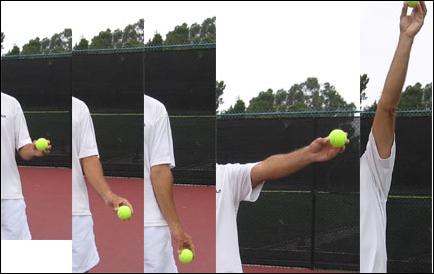 Just how does the toss arm work? Down straight and up straight? Down and back toward the racket arm and then up and forward to the net making a circular motion?
Just how does the toss arm work? Down straight and up straight? Down and back toward the racket arm and then up and forward to the net making a circular motion?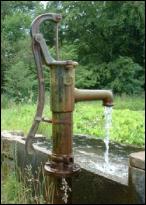 Tennis personalities Vic Braden and Jack Groppel claim "shoulder rotation" for the serve is achieved by dropping the toss arm down and swinging it across the front of your body back toward the racket arm and then swinging it back up and forward to toss the ball, creating a roundabout circular motion. There is no evidence shoulder rotation is lost without a roundabout circular motion, just look at Pete Sampras, Gonzalez, or virtually any other great server. The fact the ball arcs on the toss back to the server or forward does not mean at all there has been a backward, roundabout circular motion of the tossing arm. "Proper" shoulder rotation accounts for why the toss arm moves like it does and it's not the other way around. Stefan Edberg is the one notable exception, his toss arm really does go back, but one example does not make the rule.
Tennis personalities Vic Braden and Jack Groppel claim "shoulder rotation" for the serve is achieved by dropping the toss arm down and swinging it across the front of your body back toward the racket arm and then swinging it back up and forward to toss the ball, creating a roundabout circular motion. There is no evidence shoulder rotation is lost without a roundabout circular motion, just look at Pete Sampras, Gonzalez, or virtually any other great server. The fact the ball arcs on the toss back to the server or forward does not mean at all there has been a backward, roundabout circular motion of the tossing arm. "Proper" shoulder rotation accounts for why the toss arm moves like it does and it's not the other way around. Stefan Edberg is the one notable exception, his toss arm really does go back, but one example does not make the rule.  You've heard the most efficient way to move an object is to move the center of the object. The middle of the toss arm is roughly the elbow, and I always picture my toss arm being pulled up from the inside of my elbow by a string like a marionette. In this way my arm is relaxed, straight, and lifting from the larger mass, the upper arm/biceps. Or you can imagine there is a hand cupping your toss arm elbow from beneath and it lifts the toss arm from that point.
You've heard the most efficient way to move an object is to move the center of the object. The middle of the toss arm is roughly the elbow, and I always picture my toss arm being pulled up from the inside of my elbow by a string like a marionette. In this way my arm is relaxed, straight, and lifting from the larger mass, the upper arm/biceps. Or you can imagine there is a hand cupping your toss arm elbow from beneath and it lifts the toss arm from that point.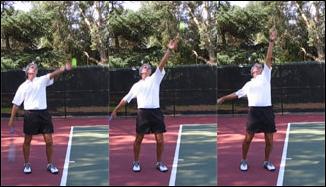 The ball leaves your hand and the arm/hand keeps going up as both part of the lifting process and to prepare itself as the upper limb on your Bow. You don't let go of the ball and stop the arm/hand, you let it go and follow through up and you're gonna hold it like that before you swing at the ball. You've heard the term "toss arm up," right? Sure, for balance, direction, control, timing. But there's more, it's to set up the Bow. The more you keep it up there to work in conjunction with your lower body the better your serve could be. Just how it works to do that I'll explain in the very last section for the serve.
The ball leaves your hand and the arm/hand keeps going up as both part of the lifting process and to prepare itself as the upper limb on your Bow. You don't let go of the ball and stop the arm/hand, you let it go and follow through up and you're gonna hold it like that before you swing at the ball. You've heard the term "toss arm up," right? Sure, for balance, direction, control, timing. But there's more, it's to set up the Bow. The more you keep it up there to work in conjunction with your lower body the better your serve could be. Just how it works to do that I'll explain in the very last section for the serve.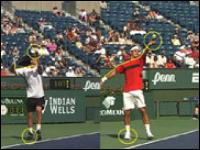 Third, move larger muscle groups to control the smaller muscle group which is your toss arm. Moving your body head to toe first (using abs and groin muscles) will help you control the toss arm to a great degree. It's not like you're standing still pitching horseshoes. You're going to shift your body weight and go into your toss motion. It's very hard to stabilize the toss by isolating the toss arm by itself, we don't toss and then shift the weight. The toss arm works with, and off of, the moving body.
Third, move larger muscle groups to control the smaller muscle group which is your toss arm. Moving your body head to toe first (using abs and groin muscles) will help you control the toss arm to a great degree. It's not like you're standing still pitching horseshoes. You're going to shift your body weight and go into your toss motion. It's very hard to stabilize the toss by isolating the toss arm by itself, we don't toss and then shift the weight. The toss arm works with, and off of, the moving body.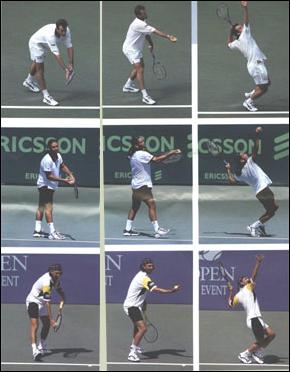
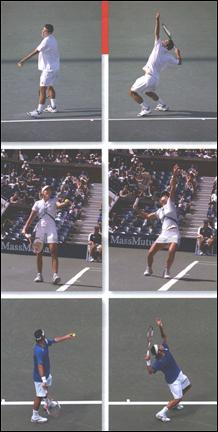
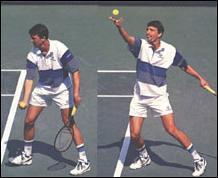
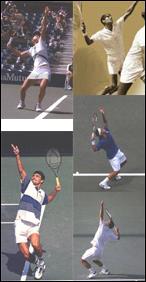 No matter if you have a low toss or a high toss you reach a point during the sequence that's called the "trophy serve": the front toss arm is up and the back arm is lower, racket held up. You can see this in the montage on the right, with Henin-Hardenne, Pancho Gonzalez, Federer, Sampras, Ivanisevic.
No matter if you have a low toss or a high toss you reach a point during the sequence that's called the "trophy serve": the front toss arm is up and the back arm is lower, racket held up. You can see this in the montage on the right, with Henin-Hardenne, Pancho Gonzalez, Federer, Sampras, Ivanisevic.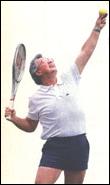
 Of course Vic exaggerates when trying to prove his point, as seen in his photo with his elbow dropped really low. A real tennis trophy he rails against does not look that way at all. And some of the pros in the montage above right have their elbow low and their toss arm up...? Hmm. Maybe he's saying the tennis trophy is wrong since there's a ball in the toss hand and not in a player's hand when the toss arm is up. Wait, that's the second ball...
Of course Vic exaggerates when trying to prove his point, as seen in his photo with his elbow dropped really low. A real tennis trophy he rails against does not look that way at all. And some of the pros in the montage above right have their elbow low and their toss arm up...? Hmm. Maybe he's saying the tennis trophy is wrong since there's a ball in the toss hand and not in a player's hand when the toss arm is up. Wait, that's the second ball...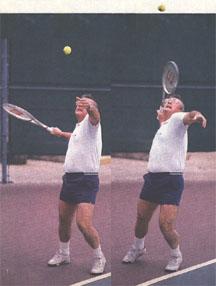
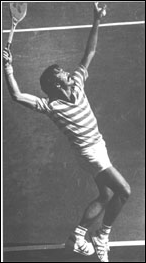 For Vic the trophy serve is a no-no, along with the high toss. A high toss indicates a player needs more time to hit it because of "hitches in their service motions that delay their swing."
For Vic the trophy serve is a no-no, along with the high toss. A high toss indicates a player needs more time to hit it because of "hitches in their service motions that delay their swing."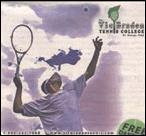 Vic opines the trophy serve leads to dropping the racket arm elbow and destroys the continuous motion. Oh, the uninitiated. Your elbow drops precipitously if you bend your racket arm too soon out of the gate, that is you must let the ball rise a good bit first while continuing to lift the racket before cocking the arm. Down together, up together, you see. You can't blame a low elbow or a lack of a continuous motion or hitches on the trophy serve, it doesn't add up if you look at the pros. Calling the trophy serve a "myth" and that it has "ruined more serves" is to do all students a disservice and hurts the game.
Vic opines the trophy serve leads to dropping the racket arm elbow and destroys the continuous motion. Oh, the uninitiated. Your elbow drops precipitously if you bend your racket arm too soon out of the gate, that is you must let the ball rise a good bit first while continuing to lift the racket before cocking the arm. Down together, up together, you see. You can't blame a low elbow or a lack of a continuous motion or hitches on the trophy serve, it doesn't add up if you look at the pros. Calling the trophy serve a "myth" and that it has "ruined more serves" is to do all students a disservice and hurts the game.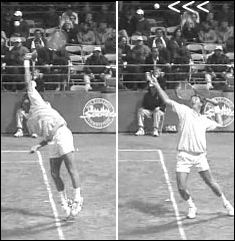 I was taught to hit the ball at the apex of the toss but I don't think I really do that. I know if I hit it while it's descending I get more action on it. Jimmy Connors comes to mind of a pro with a low toss, and a couple of others, but I found a good clip on tennisone.com to calculate his ball toss height. From slightly above but looking parallel across the court we see his ball rise (photo right with arrowheads) above the head of a seated adult male spectator in the near background to the left with the white baseball cap and the ball drops to below his chin at contact. My guess is 12 to 18 inches of drop.
I was taught to hit the ball at the apex of the toss but I don't think I really do that. I know if I hit it while it's descending I get more action on it. Jimmy Connors comes to mind of a pro with a low toss, and a couple of others, but I found a good clip on tennisone.com to calculate his ball toss height. From slightly above but looking parallel across the court we see his ball rise (photo right with arrowheads) above the head of a seated adult male spectator in the near background to the left with the white baseball cap and the ball drops to below his chin at contact. My guess is 12 to 18 inches of drop.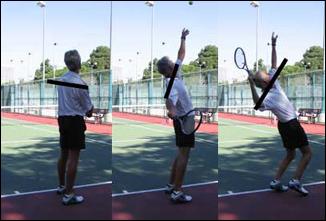 Big secret here, but it's an easy one. You toss the ball, the toss arm goes down and up; the racket arm drops and rises. You know this. Now turn the back shoulder sideways more -- and keep that toss arm out in front where it's supposed to be. Voila, you now have "proper" shoulder rotation being set up and you didn't have to start out convoluted and take the toss arm back, down, and up.
Big secret here, but it's an easy one. You toss the ball, the toss arm goes down and up; the racket arm drops and rises. You know this. Now turn the back shoulder sideways more -- and keep that toss arm out in front where it's supposed to be. Voila, you now have "proper" shoulder rotation being set up and you didn't have to start out convoluted and take the toss arm back, down, and up.